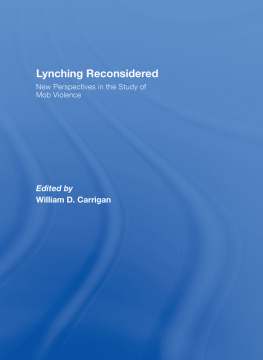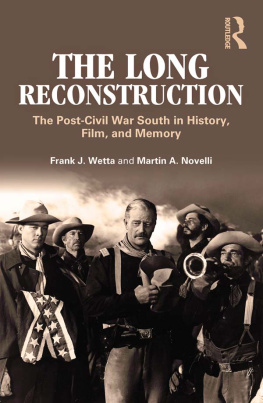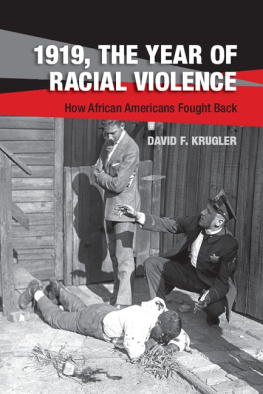The Record of Murders and Outrages
CIVIL WAR AMERICA
Peter S. Carmichael, Caroline E. Janney,
and Aaron Sheehan-Dean, editors
This landmark series interprets broadly the history and culture of the Civil War era through the long nineteenth century and beyond. Drawing on diverse approaches and methods, the series publishes historical works that explore all aspects of the war, biographies of leading commanders, and tactical and campaign studies, along with select editions of primary sources. Together, these books shed new light on an era that remains central to our understanding of American and world history.
2021 William A. Blair
Designed by Jamison Cockerham
Set in Arno, Scala Sans, Cutright, and Irby
by codeMantra
Cover illustration: Scenes in Memphis, during the Riot, by Alfred R. Waud. From Harpers Weekly, May 26, 1866. Courtesy Library of Congress.
Manufactured in the United States of America
The University of North Carolina Press has been a member of the Green Press Initiative since 2003.
LIBRARY OF CONGRESS CATALOGING-IN-PUBLICATION DATA
Names: Blair, William Alan, author.
Title: The record of murders and outrages : racial violence and the fight over truth at the dawn of Reconstruction / William A. Blair.
Other titles: Civil War America (Series)
Description: Chapel Hill : University of North Carolina Press, [2021] |
Series: Civil War America | Includes bibliographical references and index.
Identifiers: LCCN 2021003506 | ISBN 9781469663449 (cloth ; alk. paper) | ISBN 9781469663456 (paperback ; alk. paper) | ISBN 9781469663463 (ebook)
Subjects: LCSH: United States. Bureau of Refugees, Freedmen, and Abandoned LandsRecords and correspondence. | FreedmenSouthern StatesHistory19th centurySources. | African AmericansViolence againstSouthern StatesSources. | Reconstruction (U.S. history, 18651877)Public opinion. | United StatesRace relationsHistory19th century. | United StatesPolitics and government18651877.
Classification: LCC E185.2 .B55 2021 | DDC 973.8dc23
LC record available at https://lccn.loc.gov/2021003506
Introduction
While working on research for another project some thirty years ago, I took a break from cranking microfilm in the Alderman Library at the University of Virginia. Walking through the stacks, I spotted reels from the National Archives containing material from the Bureau of Refugees, Freedmen, and Abandoned Lands, commonly called the Freedmens Bureau. At the time, I thought the material might inform my thinking about the appropriate end point of my research, which potentially straddled the end of the Civil War and the early days of Reconstruction. Taking one reel back to my reader, I threaded the spool and stopped at the title page, which read, Records Relating to Murders and Outrages.1
The title startled me. Such powerful words in a government record dating from that era made clear that its creators were reporting bona fide atrocities, and inclusion within the Freedmens Bureau archives indicated that African Americans had been the targets. But who had originated the reports and for what purpose? Had they helped bring the perpetrators to justice? Or did the material represent another example of information gathered by a bureaucracy only to be filed and ignored in the bowels of government archives?
It turns out that the Records Relating to Murders and Outrages were central to one of the most important conflicts of the Reconstruction eraa conflict that was, at its heart, a war over trustworthy information.
The thousands of pages that make up the records reveal that federal agents gathered intelligence to prove the pervasiveness of racial conflict and violent atrocities against freedpeople in the Reconstruction South. The moment was awash in debate and confusion, particularly about the accuracy of news that had begun to emanate out of the former Confederate states about such atrocities. In the first months after the end of the Civil War, disputes over information raged along partisan lines. Democrats and conservative Republicans accused Radicals in Congress of distorting the extent of criminal behavior perpetrated by Southerners. The critics alleged that Radicals fabricated or exaggerated the stories of violence in order to send the military into the South on a supposed mission of mercy that hid a baser motiveto expand the partys base through Black manhood suffrage. In a media landscape that was as partisan as the halls of government, Democrats and conservative Republicans refused to believe correspondents from opposing newspapers about lawlessness. Doubters also rejected the testimony from witnesses delivered before congressional committees under oath and denied the existence of the Ku Klux Klan.2
Even when confronted with seemingly hard evidence, critics dismissed the murders, rapes, assaults, and other outrages on Black people as either cultural or social conflicts rather than struggles over political power to maintain white supremacy. They claimed that if African Americans experienced crime, it was nothing more than the usual violence occurring everywhere in America, including between white people. They also claimed, without proof, that white people were more often the victims of outrages perpetrated by Black people.
In an effort to produce unmistakable evidence, officers of the Freedmens Bureau stationed in Southern communities after the Civil War documented racial violence to show that former rebels persecuted freedpeople and white Republicans through terrorism. Without the knowledge of President Andrew Johnson, they began to collect the data and eventually leaked it to Radicals in the Senate. Their efforts contradicted Johnsons policies and supported passage of legislation for military rule of the South.3
The records also make it clear that Black people laid their lives on the line to supply the documentation. White supremacists resented the Freedmens Bureau in their communities and used all forms of intimidation, including murder, to prevent African Americans from testifying about the injustice they faced. Freedpeople encountered a law enforcement system stacked against them and civil courts that failed to prosecute the criminals who perpetrated acts against them. Because of this, Freedmens Bureau officers estimated that they received news of only a fraction of the outrages committed against Black people.
The sacrifices that Black people endured to share their testimony of white atrocities made an impact. Military Reconstruction led to newly elected Republican governments in the South, which in turn adopted Black manhood suffrage. Those governments also ratified the Fourteenth Amendment, which empowered the federal government to protect individual liberties. The intelligence on violence gathered by the Freedmens Bureau influenced other debates and policy formation. The monthly reports exposed the election intimidation that threatened newly registered Republican voters and put Georgia and Louisiana in the hands of Democrats. The information helped slow the timetable for readmission of states, especially Georgia.4







